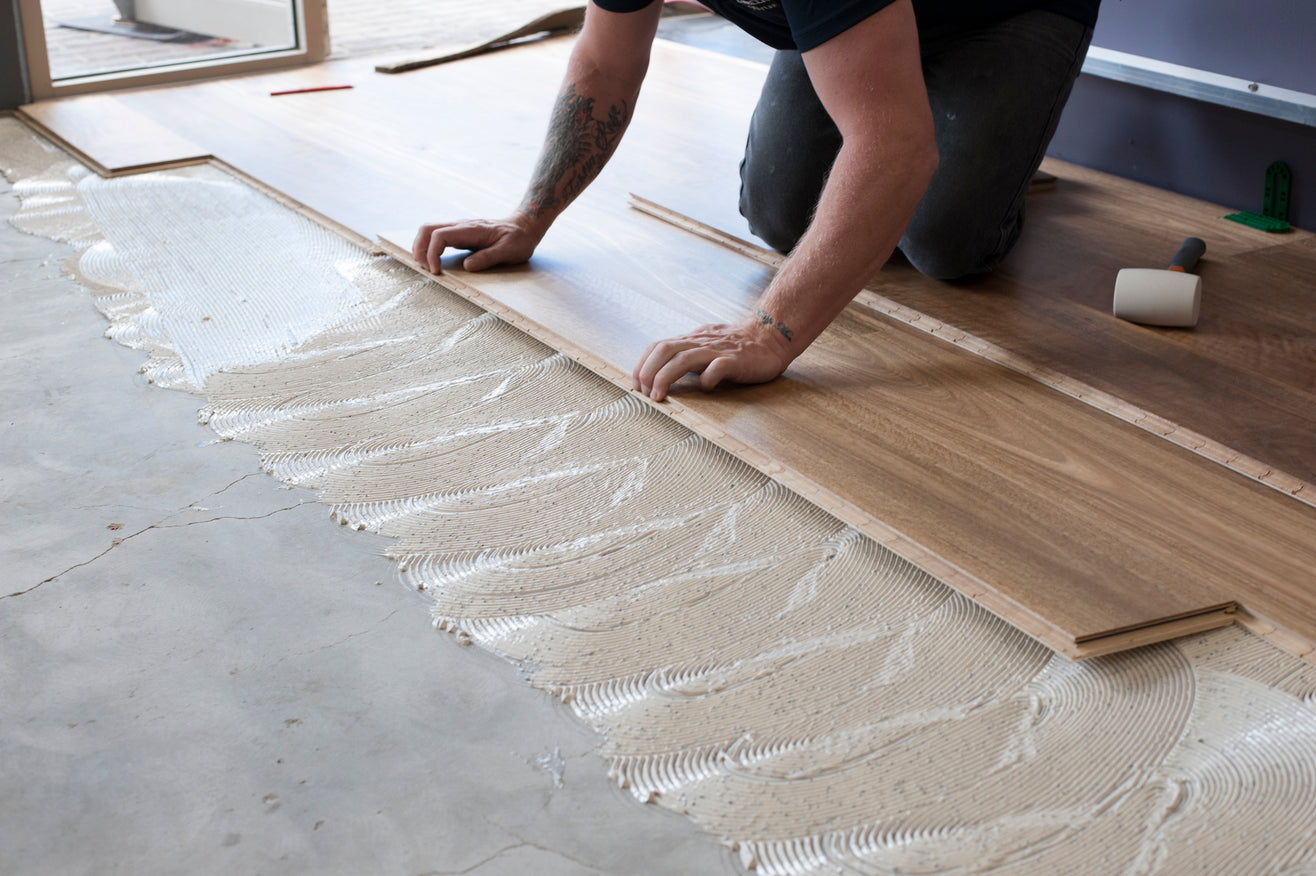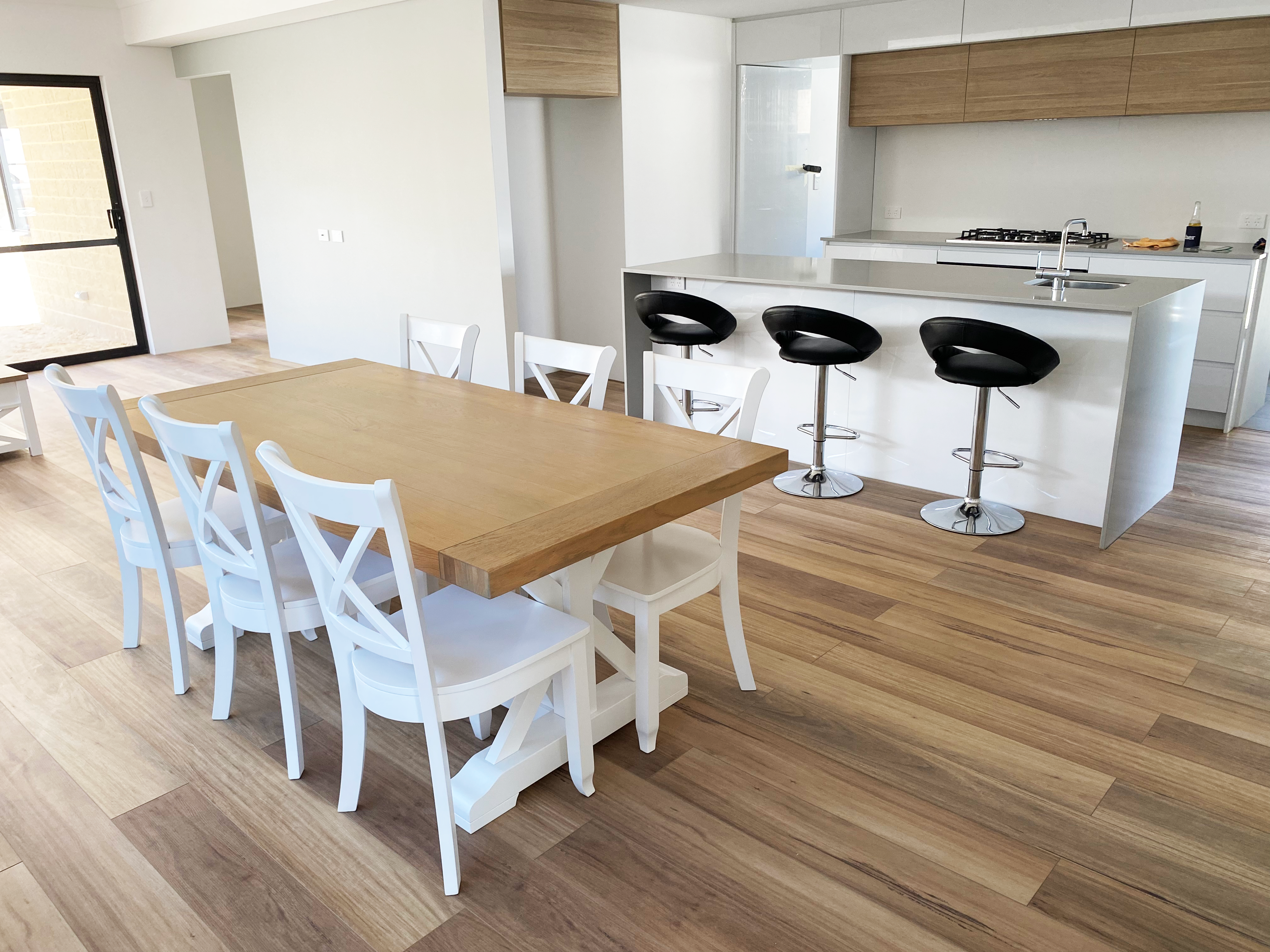
So you’ve found the perfect floor for your home and now it’s time to install. Flooring Online’s range of floorboards are designed for maximum flexibility, and can be installed over virtually any substrate that is clean of debris, flat and structurally sound, either by the direct stick method, or as a floating floor.
This guide will help you decide which method is right for your installation.
Floating Floors
As the name suggests, a floating installation is one where the product is installed without an adhesive bonding the material to the substrate, and therefore the timber is effectively ‘floating’ as a raft on top of an acoustic flooring underlay.
The main benefit to installing your floors as a floating system is speed and cost. Because our floors feature the licensed locking systems including Valinge 5G, a floating installation is easy, quick and well within the capability of many DIY installers. Floating floors are cost effective and create very little mess, as adhesive is not required.
Additionally, floating floors can be installed over virtually any surface, including those that may not be suitable for direct stick adhesion such as existing ceramic tiles or structural hardwood, while for slab-on-grade installations or in homes susceptible to rising damp, our plastic underlay ensures your floors are protected from moisture ingress.
Finally, floating floors allows for flexibility. Interior trends change over time and, in the case of rental properties, tenants come and go. Floating floorboards can easily be lifted and replaced in the future in response to changing taste, damage or normal wear and tear.
When installing floating floors it is critical that the correct provision for the expansion and contraction of the product is allowed for. This means leaving the appropriate gaps at the perimeter of the installation, which should be covered by either skirting boards fitted after installation or scotia and ensuring the appropriate maximum raft sizes are adhered to and expansion joins fitted at the specified intervals.
Still unsure about a floating floor board system? Here is a diagram showing the layers of a floating system and what is required to lay your floors correctly and professionally.

Similarly, floating floors need proper preparation. Installing floating floors over uneven subfloors can lead to a soft or bouncy floor, squeaky joins and in extreme cases broken end joints. Please thoroughly read the provided installation instructions before installing your new floors.
Direct Stick (Glue Down)
Direct Stick floor boards are adhered directly to the subfloor, usually with an MS adhesive such as our recommended adhesive, Bostik 3in1. A derivative of the direct stick installation method is dual bonding, where an acoustic rubber underlay is first glued to the subfloor, then the timber is glued to the underlay for increased acoustic performance.
The main benefit of direct stick floor is the solid feel and sound that it provides underfoot, making the installation indistinguishable from a solid hardwood flooring installation. Additionally, while the adhesive is designed to provide a degree of flexibility it significantly reduces the potential expansion and contraction of the product, meaning smaller expansion gaps can be maintained that are small enough to be caulked without the need for trims and scotia, and the maximum allowable rafts are bigger, meaning fewer expansion joins are required.

By utilising the direct stick method, there are no worries for creaking in your floor to occur as well as any deflection. The acoustic rating of the Direct Stick system is 53db, which is noticeably quieter than the floating floor system, and once the flooring is laid, one can immediately walk on the floor, unlike a floating floor. Many timber adhesives available on Flooring Online offer different features and benefits, such as Acoustic properties and inbuilt Moisture Barrier.
To hear the difference between a Floating floor and a Direct Stick timber floor please watch the video below.
A golf ball is rolled and bounced across both flooring types to mimic a pair of heeled shoes walking across the floor. It is important when selecting flooring to talk to a professional about the installation of your new floors, as not all floors can be glued down.
How to install my new floors?
| Product Type | Floating Floor | Direct Stick (Glue) | Recommend Installation Products |
|
Engineered Australian Timber |
 |

|
Timber Adhesive: Bostik 3in1 Underlay: Hush Platinum |
|
Engineered European Oak |

|

|
Timber Adhesive: Bostik 3in1 Underlay: Hush Platinum |
|
Engineered Timber (T&G) |
 |

|
Timber Adhesive: Bostik 3in1 |
|
Timber Hybrid |

|

|
Underlay pre-attached to the floorboards |
|
Hybrid Flooring |

|

|
Underlay pre-attached to the floorboards |
|
Laminate Flooring |

|

|
Underlay: Hush Platinum |
|
Luxury Vinyl Planks |

|

|
Timber Adhesive: Bostik Uni-Lock |
|
Cirrus Carpet |

|

|
Timber Adhesive: Bostik Uni-Lock |
|
Carpet Tiles |

|

|
Timber Adhesive: Bostik Uni-Lock |
This guide was designed to help you find the best suited flooring system to help you install your floors and hopefully answer some of your questions about the main differences on the Direct Stick method and the Floating Floor method. These two methods are the most effective ways to lay your floor, and each system have their benefits and challenges. If you have recently purchased or looking to purchase Flooring Online floors and have questions, then look out for our blogs where we will help solve your queries.
By James Embelton




1 comment